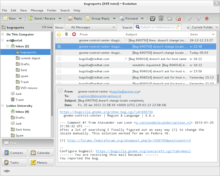Email, a vital communication tool since its introduction in 1975, has become an integral part of our daily lives. This system functions over computer networks and the Internet[1], enabling global message transmission and reception. While ’email’ is the commonly accepted term in style guides, variations such as ‘E-mail’ are occasionally used, especially in American and British English contexts. The process of this system includes a sender composing a message via a Mail User Agent (MUA), which then sends it to the recipient’s mail exchange server. The recipient’s MUA subsequently retrieves the message. Thanks to the Multipurpose Internet Mail Extension (MIME), emails can now include multimedia content. For safety, email systems employ a store-and-forward model, whereby email servers receive, forward, store, and deliver messages. This method facilitates email exchanges without requiring users to be online simultaneously.
Electronic mail (courriel ou e-mail) is a method of transmitting and receiving messages using électronique devices. It was conceived in the late–20th century as the digital version of, or counterpart to, courrier (hence e- + mail). Email is a ubiquitous and very widely used communication medium; in current use, an adresse électronique is often treated as a basic and necessary part of many processes in business, commerce, government, education, entertainment, and other spheres of daily life in most countries.


Email operates across les réseaux informatiques, primarily the Internet, and also local area networks. Today's email systems are based on a store-and-forward model. Email servers accept, forward, deliver, and store messages. Neither the users nor their computers are required to be online simultaneously; they need to connect, typically to a mail server ou un webmail interface to send or receive messages or download it.
Originally an ASCII text-only communications medium, Internet email was extended by Multipurpose Internet Mail Extensions (MIME) to carry text in other character sets and multimedia content attachments. International email, with internationalized email addresses using UTF-8, is standardized but not widely adopted.